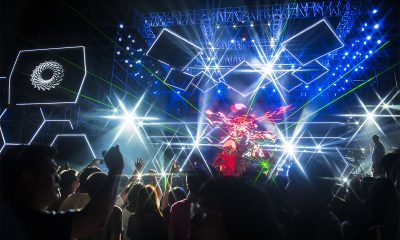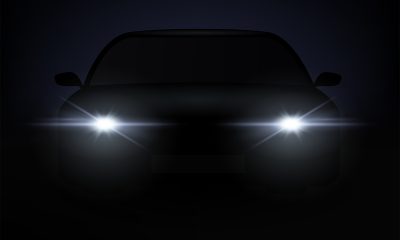What is a laser diode
A laser diode (LD) package is a semiconductor device capable of producing a collimated beam of high intensity light by stimulated emission of radiation. It consists of a gain medium surrounded with a resonant cavity. The gain medium is typically fabricated from semi-polar orientation gallium nitride (GaN) and consists of multi-quantum wells (MQWs). The use of III-nitride semiconductors allows the emission wavelength to be tuned from the near-infrared to the UV range by varying the alloy composition. A III-nitride diode laser has a p-i-n structure in which the active region of the laser diode is in the intrinsic (I) region. Lasing is achieved by applying a potential difference across the p-n junction. When a p-n junction diode is forward biased, charge carriers (electrons from n-region and holes from the p-region) are pumped into the active region and recombine with each other. The radiative electron-hole recombination causes the electrons to drop down from the conduction band by releasing energy in the form of photons. These photons will trigger a chain of stimulated recombination resulting in the release of a stream of coherent and highly directional photons.
How does a laser diode work
A laser diode operates on similar principles as that of a light-emitting diode (LED) with a double heterojunction (DHJ) structure and employs similar concepts in solid-state physics. However, the emission of photons from a laser diode package is dominated by stimulated emission, whereas LEDs emit light through the process of spontaneous emission. Spontaneous emission refers to the process where an electron moves from a higher energy state to a lower one (i.e., transition from the conduction band to the valence band). Stimulated emission is a process that uses external influence to cause the transition of an electron from the conduction band to the valence band. It occurs when the threshold drive current is reached. A laser diode driven below the threshold current operates with just spontaneous emission of radiation. Once LDs are biased above their threshold, photons originated in spontaneous emission stimulate the radiative electron-hole recombination thereby creating additional photons with the same energy and phase as the incident photon. This “cloning” of photons requires a greater population of electrons in the excited state than in ground state to achieve population inversion. At sufficiently high carrier injection, the light in the resonant cavity, which consists of a waveguide terminated on each end by a mirror, is amplified by stimulated emission. The light oscillates within the resonant cavity and grows in strength. By maintaining a sufficient magnitude of amplification, the laser beam is produced and exits from the partially transparent mirror.
How laser diodes outperform LEDs
Stimulated emission lends laser diodes distinctive capabilities that are not attainable with LED lighting. LEDs suffer from efficiency droop, i.e., reduction of quantum efficiency at high injection current densities. The main proposed mechanism for LED efficiency droop is Auger recombination. Auger recombination refers to a physical process occurring in semiconductors under electrical or optical excitations, where electrons recombine with holes of different momentum (i.e., a non-vertical inter-band transition) without emitting photons. The Auger recombination rate increases nonlinearly with carrier density and hence current density. Auger recombination puts an efficiency limits on InGaN LEDs in which carrier recombination proceeds only through spontaneous emission. The quantum efficiency of LEDs peaks at a relatively low input power density of about 10 A/cm², and drops rapidly with rising input power density.
LDs are not plagued by efficiency droop once they are biased above their threshold. The stimulated emission process consumes all excess carriers that otherwise may participate in the non-radiative Auger recombination process. It amplifies photons to create more photons by stimulating an atom. Therefore, LDs can be driven at extremely high power densities (100 to 1000 times that of InGaN LEDs) for the proportionally high output without efficiency droop. This ability not only translates to a high luminous efficiency, but also means that an extraordinary amount of lumens can be produced from an LD for with a small chip size. In contrast to an LED that creates incoherent photons with a wide divergence, a laser diode can create a stream of coherent and highly directional photons. Ultimately, laser diodes can produce highly collimated directional beams of powerful light with a luminance of over 1000 cd/ mm². The intense beam can pierce darkness with several times the throw distance previously achieved, which is advantageous in a variety of applications, including high beam vehicle lighting, searching lighting, stage lighting, landscape spotlighting, etc.
Thermal management
Laser diodes produce narrow-band emissions having typical full width at half maximum (FWHM) of a few nanometers. The color (wavelength) of the light emitted by the LD depends on the energy difference between conduction-band electrons and valence-band electrons. Monochromatic LDs come in a wide range of wavelength options, ranging from ultraviolet (UV) to infrared (IR). To produce full-spectrum white light from LDs, blue laser diodes are typically used to pump phosphors within the device packages. The maximum driving current capability is limited by the device’s high temperature behavior. Under high power operation, a laser diode generates a considerable amount of heat which has to be dissipated via thermal conduction along the internal thermal path and then efficiently transfer the heat to the ambient atmosphere via convection and radiation. Impeding flow of heat flux from chip to the ambient will cause self-heating, which subjects the diode to thermal rollover and eventual device failure.
When the thermal load of a laser diode lighting system is too high to be properly dissipated by passive heat sinking, active cooling may be the only solution. Heat sinking of the phosphor down-converter remains an important consideration as Stokes shift heating and light absorption can produce an unusually high thermal stress to phosphors and binding materials. Laser diodes are current driven devices. The driver circuit should provide accurate control of the forward current flowing through the LDs in order to achieve a consistent light output. Pulse width modulation (PWM) dimming is recommended for intensity adjustment of laser diodes.









Loading...